by Bruce Wells | Mar 4, 2024 | This Week in Petroleum History
March 4, 1918 – West Virginia Well sets World Depth Record –
Hope Natural Gas Company completed an oil well at a depth of 7,386 feet on the Martha Goff farm in Harrison County, West Virginia. The well, drilled northeast of Clarksburg using cable-tools, was the world’s deepest at the time — until surpassed by a 1919 well drilled in nearby Marion County. The previous world depth record had been 7,345 feet for a well in Germany.
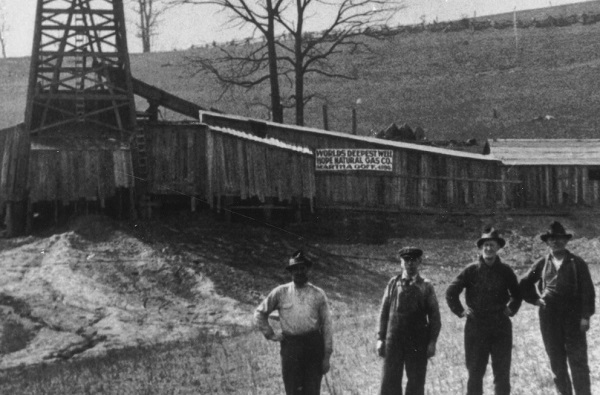
This 1918 West Virginia oil well was the world’s deepest. Photo courtesy West Virginia Oil and Natural Gas Association.
In 1953, the New York State Natural Gas Corporation claimed the world’s deepest cable-tool well at a depth of 11,145 feet near the New York town of Van Etten. By 2018, a rotary rig depth record was reached by a Russian well drilled 40,502 feet deep on Sakhalin Island.

March 4, 1933 – Oklahoma City Oilfield under Martial Law
Oklahoma Governor William H. “Alfalfa Bill” Murray declared martial law to enforce his regulations strictly limiting production in the Oklahoma City oilfield, discovered in December 1928. Two years earlier, Murray had called a meeting of fellow governors from Texas, Kansas and New Mexico to create an Oil States Advisory Committee, “to study the present distressed condition of the petroleum industry.”

William “Alfalfa Bill” Murray in 1932.
Elected in 1930, the controversial politician was called “Alfalfa Bill” because of speeches urging farmers to plant alfalfa to restore nitrogen to the soil. By the end of his administration, Murray had called out the National Guard 47 times and declared martial law more than 30 times. He was succeeded as Oklahoma governor by E.W. Marland in 1935.
March 4, 1938 – Giant Oilfield discovery in Arkansas
The Kerr-Lynn Oil Company (a Kerr-McGee predecessor) completed its Barnett No. 1 well east of Magnolia, Arkansas, discovering the giant Magnolia oilfield, which would become the largest producing field (in volume) during the early years of World War II, helping to fuel the American war effort.

Crew members stand in front of their 1938 giant oilfield discovery well at Magnolia, Arkansas. Photo courtesy W.B. “Buzz” Sawyer.
The southern Arkansas gusher launched a Columbia County oil boom similar to Union County’s Busey-Armstrong No. 1 well southwest of El Dorado in January 1921.
March 5, 1895 – First Wyoming Refinery produces Lubricants
Near the Chicago & North Western railroad tracks in Casper, Civil War veteran Philip “Mark” Shannon and his Pennsylvania investors opened Wyoming’s first refinery. It could produce 100 barrels a day of 15 different grades of lubricant, from “light cylinder oil” to heavy grease. Shannon and his associates incorporated as Pennsylvania Oil and Gas Company.
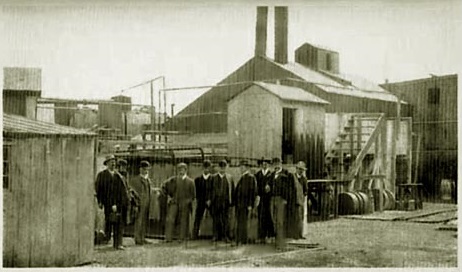
The original Casper oil refinery in Wyoming, circa 1895. Photo courtesy Wyoming Tales and Trails.
By 1904, Shannon’s company owned 14 wells in the Salt Creek field, about 45 miles from the company’s refinery (two days by wagon). Each well produced up to 40 barrels of oil per day. Despite Casper’s improved railroad access, transportation costs meant Wyoming oil could not compete for eastern markets. The state’s first petroleum boom would have to wait until 1908, when Salt Creek’s “Big Dutch” well was completed.
Learn more in First Wyoming Oil Wells.

March 6, 1935 – Search for First Utah Oil proves Deadly
More than a decade before Utah’s first commercial oil wells, residents of St. George had hoped the “shooting” of a well drilled by Arrowhead Petroleum Company would bring black gold prosperity. A crowd had gathered to watch as workers prepared six, 10-foot-long explosive canisters to fracture the 3,200-foot-deep Escalante No. 1 well.

A 1935 attempt to find oil in Utah proved deadly. Photo courtesy Washington County Historical Society.
An explosion occurred as the torpedoes, “each loaded with nitroglycerin and TNT and hanging from the derrick,” were being lowered into the well. Ten people died from the detonations, which “sent a shaft of fire into the night that was seen as far as 18 miles away.”
The 1935 accident has remained the worst oil-related disaster in Utah, according to The Escalante Well Incident, a 2007 historical account.
March 6, 1981 — Shale Revolution begins in North Texas
Mitchell Energy and Development Corporation drilled its C.W. Slay No. 1 well, the first commercial natural gas well of the Barnett shale formation. Over the next four years, the vertical well in North Texas produced nearly a billion cubic feet of gas, but it would take almost two decades to perfect cost-effective shale fracturing methods combined with horizontal drilling.
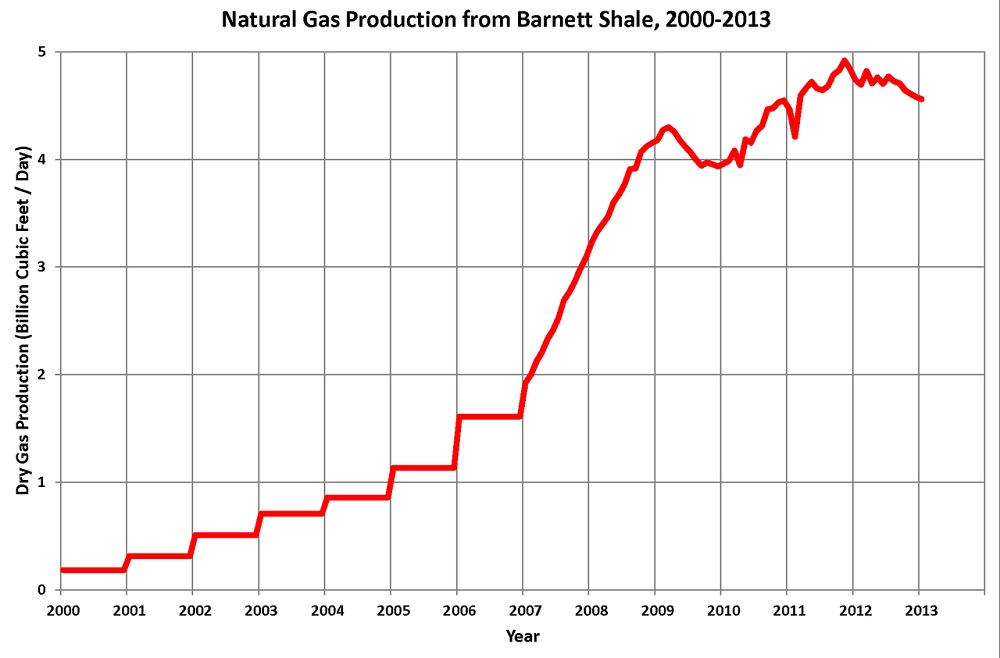
Production from the Barnett shale formation extends from Dallas west and south, covering 5,000 square miles, according to the Texas Railroad Commission. Chart courtesy Dan Plazak.
Mitchell Energy’s 7,500-foot-deep well and others in Wise County helped evaluate seismic and fracturing data to understand deep shale structures. “The C.W. Slay No. 1 and the subsequent wells drilled into the Barnett formation laid the foundation for the shale revolution, proving that natural gas could be extracted from the dense, black rock thousands of feet underground,” the Dallas Morning News later declared.
By the end of 2012, with almost 14,000 wells drilled in the largest gas field in Texas, production started to decline, but the Barnett field still accounted for 6.1 percent of Texas natural gas production and 1.8 percent of the U.S. supply, according to the Federal Reserve Bank of Dallas.
March 7, 1902 – Oil discovered at Sour Lake, Texas
Adding to the giant oilfields of Texas, the Sour Lake field was discovered about 20 miles west of the world-famous Spindletop gusher of January 1901. The spa town of Sour Lake quickly became a boom town where major oil companies, including Texaco, got their start.
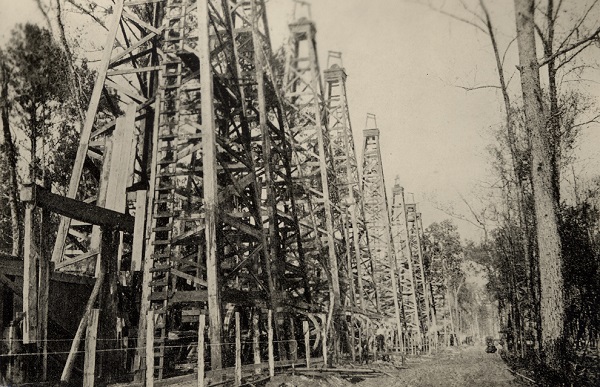
“The resort town of Sour Lake, 20 miles northwest of Beaumont, was transformed into an oil boom town when a gusher was hit in 1902,” notes the Texas State Library and Archives Commission.
Originally settled in 1835 and called Sour Lake Springs because of its “sulphureus spring water” known for healing, the sulfur wells attracted many exploration companies. Some petroleum geologists predicted a Sour Lake salt dome formation similar to that revealed by Pattillo Higgins, the Prophet of Spindletop.
Sour Lake’s 1902 discovery well was the second attempt of the Great Western Company. The well, drilled “north of the old hotel building,” penetrated 40 feet of oil sands before reaching a total depth of about 700 feet. The Hardin County’s salt dome oilfield yielded almost nine million barrels of oil by 1903, when the Texas Company made its first major oil find at Sour Lake.
Learn more in Sour Lake produces Texaco.

March 7, 2007 – National Artificial Reef Plan updated
The National Marine Fisheries Service of the National Oceanic and Atmospheric Administration (NOAA), approved a comprehensive update of the 1985 National Artificial Reef Plan, popularly known as the “rigs to reefs” program.

A typical platform provides almost three acres of feeding habitat for thousands of species. Photo courtesy U.S. Bureau of Safety and Environmental Enforcement.
The agency worked with interstate marine commissions and state artificial reef programs, “to promote and facilitate responsible and effective artificial reef use based on the best scientific information available.” The revised National Artificial Reef Plan included guidelines for converting old platforms into reefs. A typical four-leg structure provides up to three acres of habitat for hundreds of marine species.
“As of December 2021, 573 platforms previously installed on the U.S. Outer Continental Shelf have been reefed in the Gulf of Mexico,” according to the Bureau of Safety and Environmental Enforcement (BSEE).
Learn more in Rigs to Reefs.
March 9, 1930 – Prototype Oil Tanker is Electrically Welded
The world’s first electrically welded commercial vessel, the Texas Company (later Texaco) tanker M/S Carolinian, was completed in Charleston, South Carolina. The World War I shipbuilding boom had encouraged new electric welding technologies. The oil company’s 226-ton vessel was a prototype designed by naval architect Richard Smith.

Construction of M/S Carolinian began in 1929. The M/S designation meant it used an internal combustion engine. Photo courtesy Z.P. Liollio.
The tanker — the first electrically welded ship — eliminated the need for about 85,000 pounds of rivets, according to a 2017 article for the International Committee for the Conservation of the Industrial Heritage (TICCIH). Success of the prototype led to “the standard of welded hulls and internal combustion engines would become universal in construction of new vessels.”

March 9, 1959 – Barbie is a Petroleum Doll
Mattel revealed the Barbie Doll at the American Toy Fair in New York City. More than one billion “dolls in the Barbie family” have been sold since. Eleven inches tall, Barbie owes her existence to petroleum products and the science of polymerization, including several plastic acronyms: ABS, EVA, PBT, and PVC.

Petroleum-based polymers are part of Barbie’s DNA.
Acrylonitrile-Butadiene-Styrene (ABS) is known for strength and flexibility. This thermoplastic polymer is used in Barbie’s torso to provide impact and heat resistance. EVA (Ethylene-Vinyl Acetate), a copolymer made up of ethylene and vinyl acetate, protects Barbie’s smooth surface.
The Mattel doll also includes Polybutylene Terephthalate (PBT), a thermoplastic polymer often used as an electrical insulator. A mineral component facilitates PBT injection molding of her “full figure,” according to the company. Barbie’s hair and many of her designer outfits are made from the world’s first synthetic fiber, nylon, invented in 1935 (see Nylon, a Petroleum Polymer).
_______________________
Recommended Reading: Where it all began: The story of the people and places where the oil & gas industry began: West Virginia and southeastern Ohio (1994); Kettles and Crackers – A History of Wyoming Oil Refineries
(1994); Kettles and Crackers – A History of Wyoming Oil Refineries (2016); Utah Oil Shale: Science, Technology, and Policy Perspectives
(2016); Utah Oil Shale: Science, Technology, and Policy Perspectives (2016); George P. Mitchell: Fracking, Sustainability, and an Unorthodox Quest to Save the Planet (2019); Sour Lake, Texas: From Mud Baths to Millionaires, 1835-1909
(2016); George P. Mitchell: Fracking, Sustainability, and an Unorthodox Quest to Save the Planet (2019); Sour Lake, Texas: From Mud Baths to Millionaires, 1835-1909 (1995); Rigs-to-reefs: the use of obsolete petroleum structures as artificial reefs
(1995); Rigs-to-reefs: the use of obsolete petroleum structures as artificial reefs (1987); Plastic: The Making of a Synthetic Century Hardcover
(1987); Plastic: The Making of a Synthetic Century Hardcover (1996); American Fads
(1996); American Fads (1985). Your Amazon purchase benefits the American Oil & Gas Historical Society. As an Amazon Associate, AOGHS earns a commission from qualifying purchases.
(1985). Your Amazon purchase benefits the American Oil & Gas Historical Society. As an Amazon Associate, AOGHS earns a commission from qualifying purchases.
_______________________
The American Oil & Gas Historical Society (AOGHS) preserves U.S. petroleum history. Please become an AOGHS annual supporter and help maintain this energy education website and expand historical research. For more information, contact bawells@aoghs.org. Copyright © 2024 Bruce A. Wells. All rights reserved.
by Bruce Wells | Feb 26, 2024 | This Week in Petroleum History
February 27, 1925 – Congress passes Osage Indians Act –
As a result of murders and a “reign of terror” in the Osage Nation, the U.S. Congress passed the Osage Indians Act of 1925, prohibiting non-Osages from inheriting headrights of tribal members possessing more than one-half Osage blood. The Osage people’s sudden wealth from oil royalties (see Million Dollar Auctioneer) had brought criminal conspiracies to the Oklahoma Indian Reservation with dozens of Osage killed for the headrights to their land.
February 27, 1962 – California Voters approve Offshore Drilling
Voters in Long Beach, California, approved the “controlled exploration and exploitation of the oil and gas reserves” underlying their harbor south of Los Angeles. The city’s charter had prohibited drilling there since a 1956 referendum, but advances in technology offered new and environmentally sensitive opportunities to exploit an additional 6,500 acres of the Wilmington oilfield. (more…)
by Bruce Wells | Feb 19, 2024 | This Week in Petroleum History
February 19, 1863 – First Pipeline Attempt to link Oilfield to Refinery –
With teamsters dominating oil transportation in Pennsylvania, independent producer James L. Hutchings designed and constructed a pipeline to transport oil from a well on a farm at Oil Creek to a refinery 2.5 miles away. He had patented a rotary pump, which he used for moving the oil through two-inch piping from the Tarr Farm to the Humboldt Refinery at Oil City. His pumps worked, but the cast-iron pipeline proved impractical when the joints leaked.

The 1863 pipeline attempt began from an oil well on the Tarr Farm (above) north of Oil City, Pennsylvania. December 1861 photograph by John Mather courtesy Library of Congress.
Hutchings’ concept of driving fluids with a rotary pump brought a key innovation for pipeline construction. In 1865, Samuel Van Syckel would break the teamsters’ monopoly by constructing a wrought iron pipeline with threaded joints that could transport 2,000 barrels of oil a day more than five miles — the first practical oil pipeline.
“It kind of shows you how multiple failures lead to success,” noted pipeline engineer Claudia Farrell in 2002. “The idea of driving fluids with a rotary pump sparked an innovation in the pipeline industry.”
Learn more early petroleum transportation history by visiting the Drake Well Museum in Titusville.

February 20, 1959 – First LNG Tanker arrives in England
After a 27-day voyage from a processing facility just south of Lake Charles, Louisiana, the world’s first liquefied natural gas tanker arrived at Canvey Island in England’s Thames estuary, the world’s first LNG terminal. The experimental Methane Pioneer demonstrated that large quantities of LNG could be transported safely across the ocean.
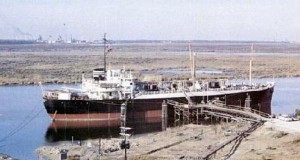
The world’s first liquefied natural gas tanker, the Methane Pioneer, was a converted World War II Liberty freighter.
The first-of-its-kind vessel, a converted World War II Liberty freighter, included five 7,000-barrel aluminum tanks supported by balsa wood and insulated with plywood and urethane. Owned by Comstock Liquid Methane Corporation, the 340-foot ship kept its methane cargo refrigerated to minus 285 degrees Fahrenheit. In June 1964, the first purpose-built commercial LNG carrier — the nine LNG tank, 618-foot Methane Princess — began regular delivery to the same Canvey Island port.
February 20, 1993 – Oil Pipe Saxophone Sculpture erected in Houston
Petroleum pipeline became a work of art when offbeat Texas sculptor Bob “Daddy-O” Wade debuted his blue, 70-foot saxophone at the opening of Billy Blues Bar & Grill on Houston’s west side.
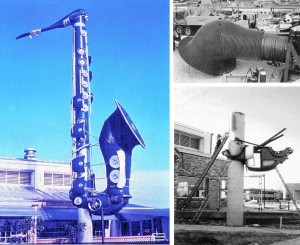
Petroleum pipeline segments contributed to a 1993 saxophone sculpture for Billy Blues Bar & Grill in Houston, Texas.
Wade transformed two 48-inch-wide pipes into the free-standing sculpture, adding an upside down Volkswagen, chrome hubcaps, beer kegs, and assorted parts to complete his blue creation. After much debate, the Houston City Council deemed the oilfield pipeline saxophone to be art rather than signage. The Fort Worth Star Telegram described Wade as a “connoisseur of Southwestern kitsch.”
Learn more in “Smokesax” Art has Pipeline Heart.

February 21, 1887 – Refining Process brings Riches to Rockefeller
Mining engineer and chemist Herman Frasch applied to patent a new process for eliminating sulfur from “skunk-bearing oils.” The former employee of Standard Oil of New Jersey was quickly rehired by John D. Rockefeller, who owned oilfields near Lima, Ohio, that produced a thick, sulfurous oil.
Standard Oil Company, which had accumulated a 40-million barrel stockpile of the inexpensive, sour “Lima oil,” bought Frasch’s patent for its copper-oxide refining process to “sweeten” the oil.
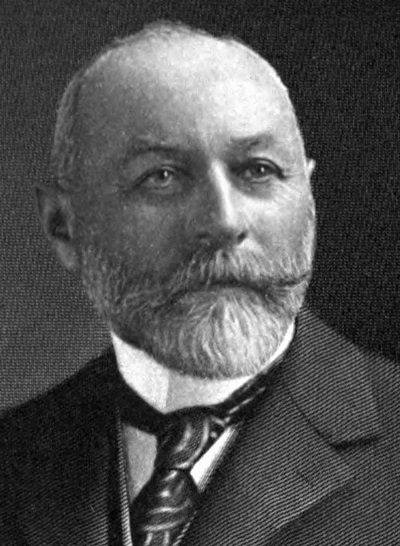
Herman Frasch (1851-1914), inventor of a key refinery process, later became known as the Sulfur King.
By the early 1890s, the Standard Oil’s giant Whiting oil refinery east of Chicago was producing odorless kerosene from desulfurized oil, making Rockefeller another fortune.
Paid in Standard Oil shares and becoming very wealthy, Frasch moved to Louisiana — where the chemist made yet another fortune. By 1911, he was known as the “Sulfur King” after inventing a method for extracting sulfur from underground deposits by injecting superheated water into wells.
February 22, 1923 – First Carbon Black Factory in Texas
Texas granted its first permit for a carbon black factory to J.W. Hassel & Associates in Stephens County. Scientists had discovered that carbon black greatly increased the durability of rubber used in tires. Produced by the controlled combustion of petroleum products, carbon black could be used in many rubber products.
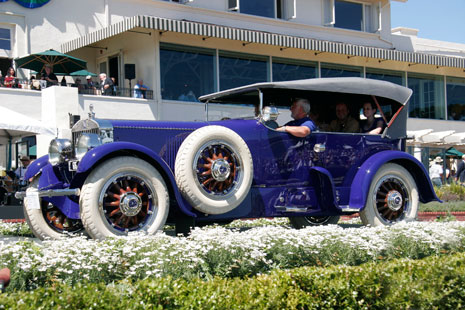
Early cars like the 1919 Pierce-Arrow had white rubber tires until B.F. Goodrich discovered carbon black improved durability. Photo courtesy Peter Valdes-Dapena.
Automobile tires were white until B.F. Goodrich Company in 1910 discovered that adding carbon black to the vulcanizing process improved strength and durability. An early Goodrich supplier was crayon manufacturer Binney & Smith Company (see Carbon Black and Oilfield Crayons).

February 23, 1906 – Flaming Kansas Gas Well makes Headlines
A small town in southeastern Kansas found itself making headlines when a natural gas well erupted into flames after a lightning strike. The 150-foot burning tower could be seen at night for 35 miles.
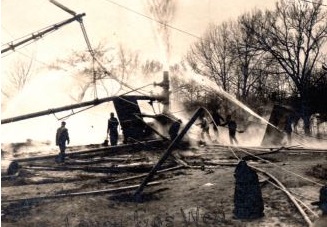
Kansas oilfield workers struggled to extinguish this 1906 well at Caney. Photo courtesy Jeff Spencer.
Drilled by the New York Oil and Gas Company, the well became a tourist attraction. Newspapers as far away as Los Angeles regularly updated their readers as technologies of the day struggled to extinguish the highly pressurized well, “which defied the ingenuity of man to subdue its roaring flames.”
A Denver publishing company sold postcards of the blazing Caney well, which took five weeks to smother using a specially designed and fabricated steel hood.
Learn more about Caney’s famed oilfield in Kansas Gas Well Fire.
February 23, 1942 – Japanese Submarine shells California Oil Refinery
Less than three months after the start of World War II, a Japanese submarine attacked a refinery and oilfield near Los Angeles. The shelling caused little damage but created the largest mass sighting of UFOs ever in American history.
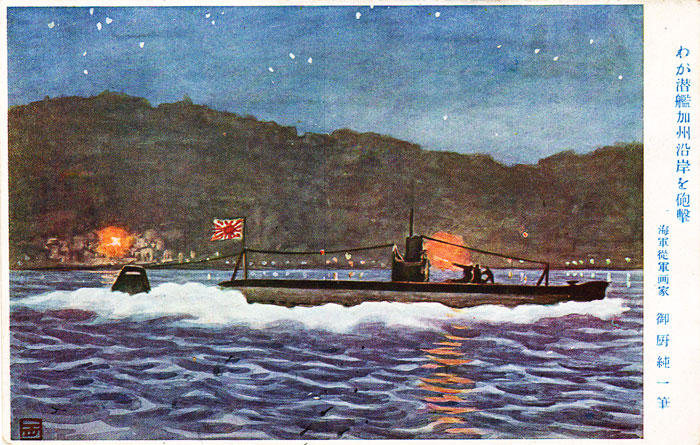
A rare Japanese postcard depicting the 1942 shelling of a California oil refinery by Imperial Navy submarine I-17. Image courtesy John Geoghegan.
Imperial Japanese Navy submarine I-17 fired armor-piercing shells at the Bankline Oil Company refinery in Ellwood City, California. The shelling north of Santa Barbara continued for 20 minutes before I-17 escaped into the night. The first Axis attack on the continental United States resulted in UFO sightings, mass hysteria and the “Battle of Los Angeles.”
Learn more in Japanese Sub attacks Oilfield.
February 24, 1938 – First Nylon Bristle Toothbrush
The Weco Products Company of Chicago, Illinois, “Dr. West’s Miracle-Tuft” toothbrush went on sale – the first to use synthetic nylon developed three years earlier by a former Harvard professor working at a DuPont research laboratory in New Jersey.
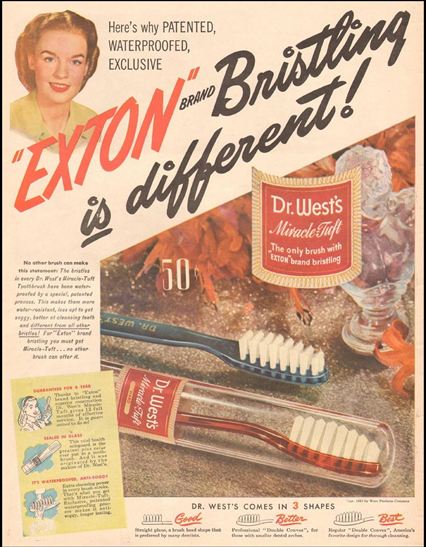
August 1938 Life magazine advertisement for first nylon bristle toothbrush.
“Until now, all good toothbrushes were made with animal bristles,” noted a 1938 Weco Products advertisement in Life magazine. “Today, Dr. West’s new Miracle-Tuft is a single exception. It is made with EXTON, a unique bristle-like filament developed by the great DuPont laboratories, and produced exclusively for Dr. West’s.”
Guaranteed for “no bristle shedding,” and selling for 50 cents ($10.61 in 2023 dollars), the toothbrush became the first commercial use of the DuPont petroleum product nylon.

February 25, 1897 – “Golden Rule” Jones elected
Samuel Jones, founder of an Ohio oilfield service company and inventor of an improved sucker rod, was elected mayor of Toledo on a progressive Republican ticket. The 40-year veteran of the Pennsylvania oilfields had become known as “Golden Rule” Jones of Ohio after posting the biblical admonition at his newly established Acme Sucker Rod Company in 1892. Jones introduced higher wages, paid vacations and bonuses while advocating the eight-hour workday. Reelected three times, Jones served as Toledo mayor until dying on the job in 1904.
February 25, 1918 – Pawnee Bill’s Oklahoma Oil Companies
As World War I neared its end, Gordon William “Pawnee Bill” Lillie entered the oil business in Yale, Oklahoma. Despite not being as famous as his Wyoming friend Col. William F. “Buffalo Bill” Cody, Lillie was a widely known showman and promoter of his state.
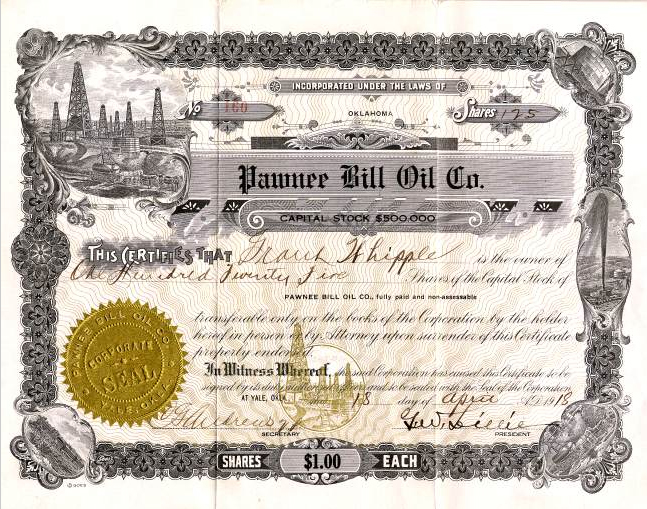
Although most are only family keepsakes, some old oil company certificates are valued by collectors.
The Pawnee Bill Oil Company operated a refinery in Yale, leasing 25 railroad tank cars during World War I. When the end of the war reduced demand for refined petroleum products, his company along with many Oklahoma refineries were soon operating at half capacity — or closed.
Although his oil company was still operating in March 1921, Pawnee Bill was forced to shut down his Yale refinery. His friend and fellow western showman Col. William Cody also tried his hand in the oil business. Cody’s Shoshone Oil Company had failed about a decade earlier in Wyoming.
February 25, 1919 – Oregon enacts First Gasoline Tax
Oil was selling for just $2 a barrel when Oregon enacted the one-cent gas tax to be used for road construction and maintenance. It was the first U.S. state to impose a gasoline tax. Less than two months later, Colorado and New Mexico followed Oregon’s example.
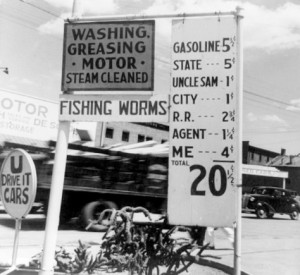
A circa 1930s service station owner explains why gas costs 20 cents a gallon in this Library of Congress photo.
By 1930, every state would add a gasoline tax of up to three cents per gallon. Faced with $2.1 billion federal deficit, President Herbert Hoover tacked on another one-cent per gallon federal excise tax in 1932.
According to the American Petroleum Institute (API), total state and federal gasoline taxes in January 2021 averaged 57.09 cents per gallon. The state-imposed tax varied from a low of 33.53 cents per gallon (Alaska) to a highs of 86.55 cents (California), 78 cents (Illinois) and 77.10 cents (Pennsylvania). The federal gasoline tax of 18.4 cents per gallon has not changed since 1993.

February 25, 1926 – Wyatt Earp’s California Oil Wells
A Kern County, California, oil well invested in by former lawman Wyatt Earp began producing 150 barrels of oil a day, confirming his belief in the field five miles north of Bakersfield. As early as 1901, drilling by the Shasta Oil Company had stirred local excitement, but the company went bust after three dry holes. In July 1924, Getty Oil Company began drilling on the Earp lease.
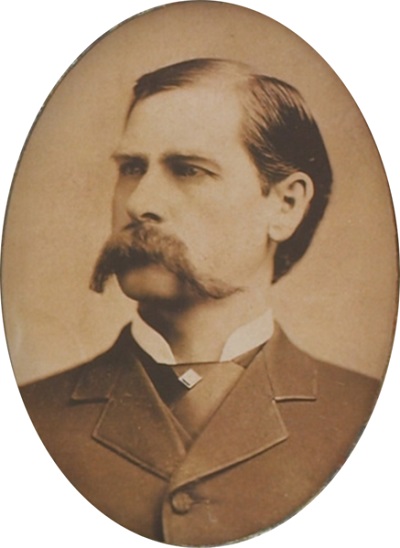
Wyatt Earp, circa 1887.
“Old Property Believed Worthless for Years West of Kern Field Relocated by Old-Timer,” declared the San Francisco Examiner, describing Earp, 75, as the “pioneer mining man of Tombstone.” The newspaper also reported, “Indications are that a great lake of oil lies beneath the surface in this territory.”
Working on his memoirs, Earp turned over management of his oil properties to his sister-in-law, and his wife noted, “I was in hopes they would bring in a two or three hundred barrel well. But I must be satisfied as it could have been a duster, too.”
Learn more in Wyatt Earp’s California Oil Wells.
_______________________
Recommended Reading: Petrolia: The Landscape of America’s First Oil Boom (2003); Natural Gas: Fuel for the 21st Century (2015); Daddy-O’s Book of Big-Ass Art (2020); Herman Frasch — The Sulphur King (2013); The B.F. Goodrich Story Of Creative Enterprise 1870-1952
(2015); Daddy-O’s Book of Big-Ass Art (2020); Herman Frasch — The Sulphur King (2013); The B.F. Goodrich Story Of Creative Enterprise 1870-1952 (2010); Caney, Kansas: The Big Gas City
(2010); Caney, Kansas: The Big Gas City (1985); The Battle of Los Angeles, 1942: The Mystery Air Raid
(1985); The Battle of Los Angeles, 1942: The Mystery Air Raid (2010); Enough for One Lifetime: Wallace Carothers, Inventor of Nylon (2005); Pawnee Bill: A Biography of Major Gordon W. Lillie
(2010); Enough for One Lifetime: Wallace Carothers, Inventor of Nylon (2005); Pawnee Bill: A Biography of Major Gordon W. Lillie (1958); Black Gold in California: The Story of California Petroleum Industry
(1958); Black Gold in California: The Story of California Petroleum Industry  (2016). Your Amazon purchases benefit the American Oil & Gas Historical Society; as an Amazon Associate, AOGHS earns a commission from qualifying purchases.
(2016). Your Amazon purchases benefit the American Oil & Gas Historical Society; as an Amazon Associate, AOGHS earns a commission from qualifying purchases.
_______________________
The American Oil & Gas Historical Society (AOGHS) preserves U.S. petroleum history. Become an AOGHS annual supporting member and help maintain this energy education website and expand historical research. For more information, contact bawells@aoghs.org. Copyright © 2024 Bruce A. Wells. All rights reserved.
by Bruce Wells | Feb 12, 2024 | This Week in Petroleum History
February 12, 1954 – First Nevada Oil Well –
After hundreds of dry holes (the first drilled near Reno in 1907), Nevada became a petroleum-producing state. Shell Oil Company’s second test of its Eagle Springs No. 1 well in Nye County produced commercial amounts of oil. The routine test revealed petroleum production from depths between 6,450 feet and 6,730 feet.

Nevada’s annual oil production peaked in 1990 at about 4 million barrels of oil. Chart courtesy Nevada Division of Minerals.
Although the Eagle Springs field eventually produced 3.8 million barrels of oil, finding Nevada’s second oilfield took two more decades. Northwest Exploration Company completed the Trap Spring No. 1 well in Railroad Valley, five miles west of the Eagle Springs oilfield in 1976.
Learn more in First Nevada Oil Well.

February 12, 1987 – Texaco Fine upheld for Getty Oil Takeover attempt
A Texas court upheld a 1985 decision against Texaco for having initiated an illegal takeover of Getty Oil after Pennzoil had made a bid for the company. By the end of the year, the companies settled their historic $10.3 billion legal battle for $3 billion when Pennzoil agreed to drop its demand for interest.
According to the Los Angeles Times, the compromise was vital for a reorganization plan for Texaco emerging from bankruptcy, a haven it had sought to stop Pennzoil from enforcing the largest court judgement ever awarded at the time.
February 13, 1924 – Forest Oil adopts Yellow Dog Logo
Forest Oil Company, founded in 1916 as an oilfield service company by Forest Dorn and his father Clayton, adopted a logo featuring the two-wicked “yellow dog” oilfield lantern. The logo included a keystone shape to symbolized the state of Pennsylvania, where Forest Oil pioneered water-flooding methods to improve production from the 85,000-acre Bradford oilfield.
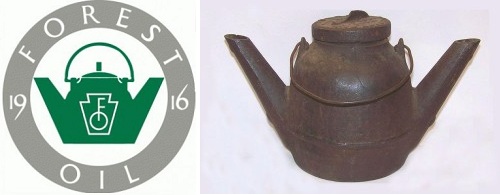
Forest Oil Company adopted the “yellow dog” lantern logo in 1924. eight years after being founded in Bradford, Pennsylvania,
Forest Oil Company‘s oilfield water-injection technology, later adopted throughout the petroleum industry, helped keep America’s first billion dollar oilfield producing to the present day. Patented in 1870, the popular derrick lamp’s name was said to come from the two burning wicks resembling a dog’s eyes glowing at night.
Learn more in Yellow Dog – Oilfield Lantern.
February 13, 1977 – Texas Ranger “El Lobo Solo” dies
“El Lobo Solo” — The Lone Wolf — Texas Ranger Manuel T. Gonzaullas died at age 85 in Dallas. During much of the 1920s and 1930s, he had earned a reputation as a strict law enforcer in booming oil towns.

Texas Ranger Manuel Gonzaullas’ “working pistols” had the trigger guard cut away.
When Kilgore became “the most lawless town in Texas” after discovery of the East Texas oilfield in 1930, Gonzaullas was chosen to tame it. “Crime may expect no quarter in Kilgore,” the Texas Ranger once declared. He rode a black stallion named Tony and sported a pair of 1911 .45 Colts with his initials on the handles.
“He was a soft-spoken man and his trigger finger was slightly bent,” noted independent producer Watson W. Wise in 1985. “He always told me it was geared to that .45 of his.”
Learn more in Manuel “Lone Wolf” Gonzaullas, Texas Ranger

February 15, 1982 – Deadly Atlantic Storm sinks Drilling Platform
With rogue waves reaching as high as 65 feet during an Atlantic cyclone, offshore drilling platform Ocean Ranger sank on the Grand Banks of Newfoundland, Canada, killing all 84 on board. At the time the world’s largest semi-submersible platform, the Ocean Ranger had been drilling a third well in the Hibernia oilfield for Mobil Oil of Canada.
The deadly weather system also engulfed a Soviet container ship 65 miles east of the platform, resulting in the loss of 32 crew members. Recommendations from the 1983 U.S. Coast Guard report would lead to improved emergency procedures, lifesaving equipment, and manning standards for other Offshore Mobil Drilling Unit (MODU) operations.
February 16, 1935 – Petroleum Producing States form Commission
A multi-state government agency that would become the Interstate Oil and Gas Compact Commission was organized in Dallas with adoption of the “Interstate Compact to Preserve Oil and Gas.” Approved by Congress in August, the commission established its headquartered in Oklahoma City.
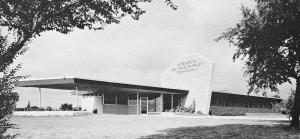
The Interstate Oil and Gas Compact Commission has been based in Oklahoma City since the mid-1930s.
Representatives from Colorado, Illinois, Kansas, New Mexico, Oklahoma and Texas began planning initiatives, “to conserve oil and gas by the prevention of physical waste thereof from any cause.” Oklahoma Gov. Ernest W. Marland — founder of Marland Oil Company in 1921 — was elected first chairman.
“Faced with unregulated petroleum overproduction and the resulting waste, the states endorsed and Congress ratified a compact to take control of the issues,” according to IOGCC, which added the word gas to its name in 1991.
February 17, 1902 – Lufkin Industries founded in East Texas
The Lufkin Foundry and Machine Company was founded in Lufkin, Texas, as a repair shop for railroad and sawmill machinery. When the pine region’s timber supplies began to dwindle, the company discovered new opportunities in the burgeoning oilfields following the 1901 discovery at Spindletop Hill.
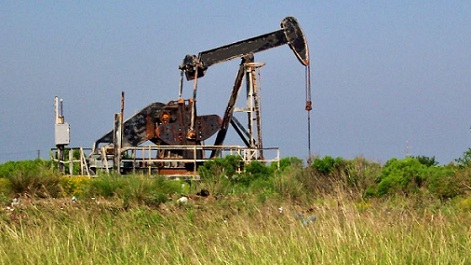
A Lufkin counter-balanced oil pump near Beaumont, Texas, in 2003. Photo by Bruce Wells.
Inventor Walter C. Trout was working for this East Texas company in 1925 when he came up with a new idea for pumping oil. His design would become an oilfield icon known by many names — nodding donkey, grasshopper, horse-head, thirsty bird, and pump jack, among others.
By the end of 1925, a prototype of Trout’s pumping unit was installed on a Humble Oil and Refining Company well near Hull, Texas. “The well was perfectly balanced, but even with this result, it was such a funny looking, odd thing that it was subject to ridicule and criticism,” Trout explained.
Learn more in All Pumped Up – Oilfield Technology.

February 17, 1944 – H.L. Hunt discovers First Alabama Oilfield
Alabama’s first oilfield was discovered in Choctaw County when independent producer H.L. Hunt of Dallas, Texas, drilled the No. 1 Jackson well. Hunt’s 1944 wildcat well revealed the Gilbertown oilfield. Prior to this discovery, 350 dry holes had been drilled in the state.
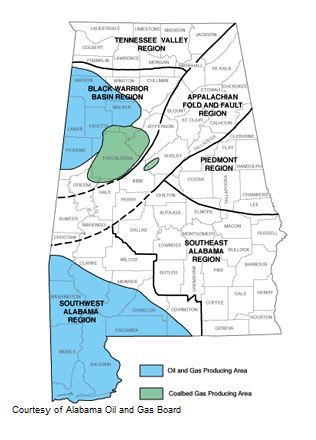
Alabama’s major petroleum producing regions are in the west. Map courtesy Encyclopedia of Alabama.
According to research by petroleum geologist Ray Sorenson, an 1858 report first noted Alabama natural oil seeps about six miles from Oakville in Lawrence County (see Exploring Earliest Signs of Oil). Hunt’s discovery well was drilled in Choctaw County, where he revealed the Gilbertown oilfield at a depth of 3,700 feet.
Although it took 11 years for another oilfield discovery, new technologies and deeper wells in the late 1980s led to the prolific Little Cedar Creek and Brooklyn fields. By the mid-2000s, geologic assessments were underway for the potential of the shales of St. Clair and neighboring counties.
Learn more in First Alabama Oil Well.
_______________________
Recommended Reading: Roadside Geology of Nevada (2027); The Taking of Getty Oil: Pennzoil, Texaco, and the Takeover Battle That Made History
(2027); The Taking of Getty Oil: Pennzoil, Texaco, and the Takeover Battle That Made History (2017); Images of America: Around Bradford
(2017); Images of America: Around Bradford (1997); Lone Wolf Gonzaullas, Texas Ranger (1998); Lufkin, from sawdust to oil: A history of Lufkin Industries, Inc.
(1997); Lone Wolf Gonzaullas, Texas Ranger (1998); Lufkin, from sawdust to oil: A history of Lufkin Industries, Inc. (1982); Lost Worlds in Alabama Rocks: A Guide
(1982); Lost Worlds in Alabama Rocks: A Guide (2000). Your Amazon purchase benefits the American Oil & Gas Historical Society. As an Amazon Associate, AOGHS earns a commission from qualifying purchases.
(2000). Your Amazon purchase benefits the American Oil & Gas Historical Society. As an Amazon Associate, AOGHS earns a commission from qualifying purchases.
_______________________
The American Oil & Gas Historical Society (AOGHS) preserves U.S. petroleum history. Please support energy education, help maintain the AOGHS website, and expand historical research for scribers to the monthly “Oil & Gas History News.” For more information, contact bawells@aoghs.org. Copyright © 2024 Bruce A. Wells. All rights reserved.
by Bruce Wells | Feb 5, 2024 | This Week in Petroleum History
February 5, 1873 – Death of an Illegal Oil Well Shooter –
Andrew Dalrymple, allegedly a frequent “moonlight oil well shooter” in the Tidioute, Pennsylvania, region, was killed in a nitroglycerin explosion at his home on Dennis Run, the Titusville Morning Herald reported. Supplies of nitroglycerin lately had been stolen from magazines throughout the oil region by those seeking to avoid fees for using the Roberts torpedo. “This species of theft is winked at by some parties, who are opposed to the Roberts torpedo patent,” the newspaper noted.
February 5, 1998 – DOE privatizes Elk Hills Petroleum Reserve
The Department of Energy and Occidental Petroleum concluded the largest divestiture of federal property in U.S. history with the sale of Elk Hills Naval Petroleum Reserve in Kern County, California. As the highest corporate bidder, Occidental ended the government’s business operations of oil and natural gas production at the 75-square-mile reserve. The $3.65 billion DOE divestment completed a privatization process that had begun years earlier.

The California Resources Corporation (CRC) in 2018 acquired the former Naval Petroleum Reserve No. 1 in Kern County. California. Map courtesy Wikimedia Commons.
The Clinton Administration in May 1995 had proposed placing the federally-owned Elk Hills reserve on the market in an effort “to reduce the size of government and return inherently non-federal functions to the private sector,” according to the DOE Office of Fossil Energy.
Discovered in 1911 and designated America’s first oil preserve one year later, Elk Hills returned to production following the 1973 oil crisis, becoming one of the top ten most productive U.S. fields. The former Naval Petroleum Reserve No. 1 — made famous by the 1922 “Teapot Dome Scandal” during the Harding administration — was acquired by California Resources Corporation (CRC) in 2018.

February 7, 1817 – First Gas Street Light
Fueled by manufactured gas (distilled from tar and wood), America’s first public street lamp illuminated Market Street in Baltimore, making Gas Light Company of Baltimore the first U.S. commercial gas lighting company. City officials erected a replica of the lamp in 1997.
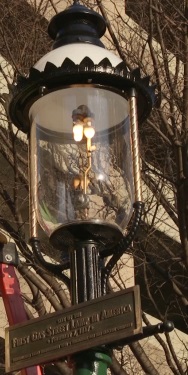
The first U.S. gas street lamp illuminated Baltimore in 1817. Photo courtesy BG&E.
Artist Rembrandt Peale earlier had demonstrated the brightness of manufactured gas with a “ring beset with gems of light” at his Baltimore museum. “During a candlelit period in American history, the forward-thinking Peale aimed to form a business around his gas light innovations, and the exhibition targeting potential investors,” notes Baltimore Gas & Electric (BG&E), which began as the Gas Light Company of Baltimore.
Learn more in Illuminating Gaslight.
February 8, 1836 – Coal Gas brightens Philadelphia
As Philadelphia became America’s center for finance and industry, a municipally owned gas distribution company began lighting Second Street. The newly formed Philadelphia Gas Works ignited 46 lamps that burned manufactured coal gas. In Washington, D.C, manufactured gas began replacing kerosene lamps in the U.S. Capitol by 1847.
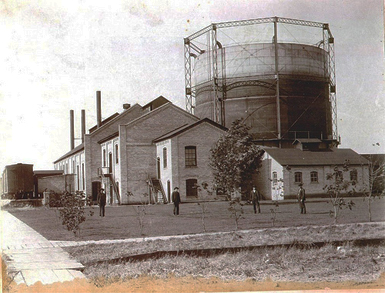
A manufactured gas storage facility at Point Breeze in South Philadelphia, circa 1856. Photograph courtesy Philadelphia Gas Works.
Philadelphia Gas Works in 1856 completed construction of a manufactured gas storage tank with a total capacity of 1.8 million cubic feet, the largest in America at the time. The village of Fredonia, New York, began the first commercial use of natural gas as early as 1825.
February 9, 2013 – Curiosity drills on Mars
Images transmitted from NASA’s robotic rover Curiosity confirmed it successfully drilled on the Martian surface, accomplishing “history’s first ever drilling and sampling into a pristine alien rock on the surface of another planet in our solar system,” according to Universe Today.

Mars rover Curiosity tested its rotary-percussion bit by making a shallow hole before drilling the first well on another planet. Photo courtesy NASA/JPL.
While exploring the Red Planet’s Yellowknife Bay Basin, Curiosity paused to drill for the first time, making a hole .63 inches wide and 2.5 inches deep. A rotary-percussion drill bit at the end of a seven-foot robotic arm penetrated a “red slab of fine-grained sedimentary rock with hydrated mineral veins of calcium sulfate.”

Curiosity’s “rotary-percussion” bit measured .6 of an inch wide. Photo courtesy NASA/JPL.
Images beamed from the site included a drill test next to the historic borehole. After completing Mars No. 1 (unofficial name), the one-ton rover drilled many others using its slow, “low-percussion” technique. Learn about terrestrial drilling methods in Making Hole – Drilling Technology.
February 10, 1910 – Giant Oilfield discovered in California
Honolulu Oil Corporation discovered the Buena Vista oilfield in Kern County, California. The well, originally known as “Honolulu’s great gasser,” was drilled further into deeper oil-producing sands, and initial production averaged 3,500 barrels of oil a day. Steam injection operations helped the field produce “heavy” (high viscosity) oil from depths of about 4,000 feet.
In 1912, as the Navy began converting its warship boilers from coal to oil (see Petroleum & Sea Power), the San Joaquin Valley oilfield was designated Naval Petroleum Reserve No. 2. In 2000, the Department of Energy leased 90 percent of the 30,000-acre Buena Vista reserves to private oil companies.

February 10, 1917 – Petroleum Geologists get Organized in Tulsa
About 90 geologists gathered in Oklahoma to form an association where “only reputable and recognized petroleum geologists are admitted.” They met at Henry Kendall College, now Tulsa University, to establish the Southwestern Association of Petroleum Geologists, today’s American Association of Petroleum Geologists (AAPG).
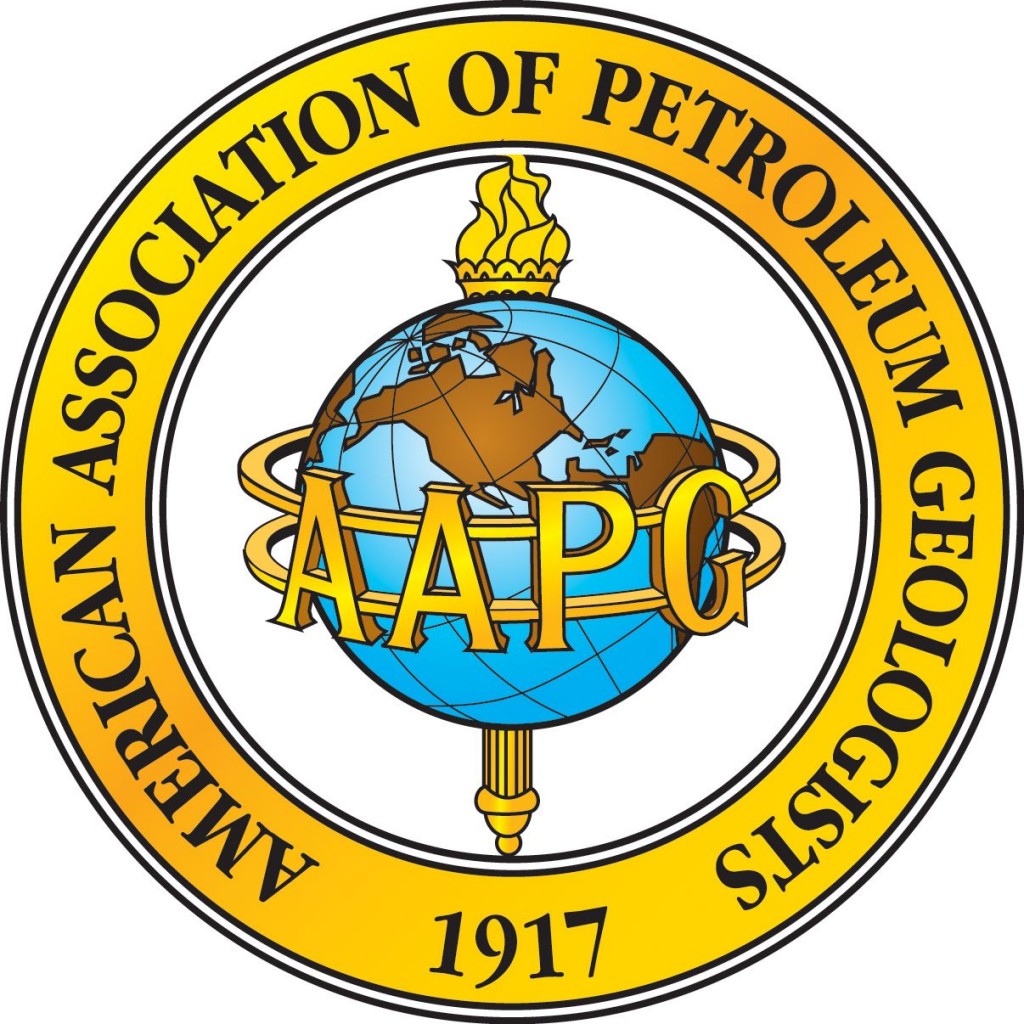
Petroleum geologists celebrated the AAPG centennial in 2017.
Adopting its current name in 1918, AAPG also launched its peer-reviewed scientific journal, the Bulletin. By 1920, industry trade magazines were praising the association’s professionalism and success combating, “unscrupulous and inadequately prepared men who are attempting to do geological work.”
AAPG in 1945 formed a committee to assist the Boy Scouts of America with a geology merit badge. The association’s membership has grown to almost 40,000 members in more than 100 countries.
Learn more in AAPG – Geology Pros since 1917.
February 10, 1956 – Frank Lloyd Wright’s Only Skyscraper
Harold C. Price Sr., founder of the pipeline construction company H.C. Price, dedicated his headquarters building in Bartlesville, Oklahoma. The 19-story concrete and copper office tower remains the only skyscraper designed by architect Frank Lloyd Wright. Wright also designed the Price family residence in Arizona, completed in 1955.
Established in 1921, H.C. Price specialized in field welding oil storage tanks and electric welding of pipelines. The company helped construct the “Big Inch” pipelines during WWII and built large sections of the 800-mile Trans-Alaska Pipeline.

Designed by Frank Lloyd Wright, the Price Tower is listed on the National Register of Historic Places. Photo by Bruce Wells.
Wright designed the Bartlesville “Prairie Skyscraper” in four quadrants, “based on the geometry of a 30-60-90 degree double parallelogram module” with one quadrant for apartments and three for offices, according the current occupant, Price Tower Arts Center. The former H.C. Price Company headquarters at Dewey Avenue and Sixth Street was listed in the National Register of Historic Places in 1974.
_______________________
Recommended Reading: Around Titusville, Pennsylvania, Images of America (2004); Black Gold in California: The Story of California Petroleum Industry
(2004); Black Gold in California: The Story of California Petroleum Industry  (2016); In Pursuit of Fame: Rembrandt Peale, 1778-1860 (1993); Mars Rover Curiosity: An Inside Account from Curiosity’s Chief Engineer
(2016); In Pursuit of Fame: Rembrandt Peale, 1778-1860 (1993); Mars Rover Curiosity: An Inside Account from Curiosity’s Chief Engineer (2017); Trek of the Oil Finders: A History of Exploration for Petroleum (1975); Building Bartlesville, 1945-2000, Images of America: Oklahoma
(2017); Trek of the Oil Finders: A History of Exploration for Petroleum (1975); Building Bartlesville, 1945-2000, Images of America: Oklahoma (2008). Your Amazon purchase benefits the American Oil & Gas Historical Society. As an Amazon Associate, AOGHS earns a commission from qualifying purchases.
(2008). Your Amazon purchase benefits the American Oil & Gas Historical Society. As an Amazon Associate, AOGHS earns a commission from qualifying purchases.
_______________________
The American Oil & Gas Historical Society (AOGHS) preserves U.S. petroleum history. Become an AOGHS annual supporting member and help maintain this energy education website and expand historical research. For more information, contact bawells@aoghs.org. Copyright © 2024 Bruce A. Wells. All rights reserved.
by Bruce Wells | Jan 29, 2024 | This Week in Petroleum History
January 29, 1850 – Kerosene Inventor patents Gasification Process –
Canadian geologist Abraham Gessner received a U.S. patent for a gas manufacturing process, “to enable others skilled in the art…for obtaining of illuminating gas from compact and fluid bitumen (crude oil), asphaltum, chapapote, or mineral pitch as found in mines, quarries and springs in the earth.” (more…)










(1994); Kettles and Crackers – A History of Wyoming Oil Refineries
(2016); Utah Oil Shale: Science, Technology, and Policy Perspectives
(2016); George P. Mitchell: Fracking, Sustainability, and an Unorthodox Quest to Save the Planet (2019); Sour Lake, Texas: From Mud Baths to Millionaires, 1835-1909
(1995); Rigs-to-reefs: the use of obsolete petroleum structures as artificial reefs
(1987); Plastic: The Making of a Synthetic Century Hardcover
(1996); American Fads
(1985). Your Amazon purchase benefits the American Oil & Gas Historical Society. As an Amazon Associate, AOGHS earns a commission from qualifying purchases.


























